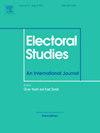Magnitude matters: Voter turnout under different electoral systems
IF 2.3
2区 社会学
Q1 POLITICAL SCIENCE
引用次数: 0
Abstract
Do voters participate more under proportional than plurality systems? While existing research typically suggests proportional representation (PR) systems exhibit higher turnout than majoritarian systems, several studies indicate a less clear-cut relationship between proportionality and voter turnout. Using a regression discontinuity design, we analyze constituency-level data from Polish municipal elections (1998-2010) to compare three electoral systems: single-member district plurality (SMDP), multi-member district plurality (MMDP), and open-list proportional representation (OLPR). This institutional setting allows us to examine both electoral formula and district magnitude effects through two transitions: from SMDP to OLPR (changing both formula and magnitude) and from MMDP to OLPR (changing primarily formula). We find that PR increases turnout by 3-4 percentage points compared to SMDP but shows no significant differences compared to MMDP. These contrasting effects suggest that district magnitude, not just electoral formula, shapes voter participation. Our findings challenge the view that proportional representation inherently increases voter participation by showing that turnout differences emerge primarily from the shift to multi-member districts. The results demonstrate how the interaction between district magnitude and electoral formula affects voting behavior, moving beyond the simple majoritarian-proportional dichotomy.
数量问题:不同选举制度下的选民投票率
比例制下的选民比多数制下的选民参与更多吗?虽然现有的研究通常表明,比例代表制(PR)比多数制表现出更高的投票率,但一些研究表明,比例和选民投票率之间的关系不那么明确。采用非连续性回归设计,我们分析了1998-2010年波兰市政选举的选区级数据,比较了三种选举制度:单成员选区多数制(SMDP)、多成员选区多数制(MMDP)和开放名单比例代表制(OLPR)。这种制度设置使我们能够通过两个过渡来检查选举公式和地区规模效应:从SMDP到OLPR(改变公式和规模),从MMDP到OLPR(主要改变公式)。我们发现,与SMDP相比,PR增加了3-4个百分点的投票率,但与MMDP相比没有显着差异。这些对比效应表明,选区的大小,而不仅仅是选举公式,决定了选民的参与。我们的研究结果挑战了比例代表制本质上增加选民参与的观点,表明投票率差异主要来自于向多成员地区的转变。结果表明,选区规模和选举公式之间的相互作用如何影响投票行为,超越了简单的多数比例二分法。
本文章由计算机程序翻译,如有差异,请以英文原文为准。
求助全文
约1分钟内获得全文
求助全文
来源期刊

Electoral Studies
POLITICAL SCIENCE-
CiteScore
3.40
自引率
13.00%
发文量
82
审稿时长
67 days
期刊介绍:
Electoral Studies is an international journal covering all aspects of voting, the central act in the democratic process. Political scientists, economists, sociologists, game theorists, geographers, contemporary historians and lawyers have common, and overlapping, interests in what causes voters to act as they do, and the consequences. Electoral Studies provides a forum for these diverse approaches. It publishes fully refereed papers, both theoretical and empirical, on such topics as relationships between votes and seats, and between election outcomes and politicians reactions; historical, sociological, or geographical correlates of voting behaviour; rational choice analysis of political acts, and critiques of such analyses.
 求助内容:
求助内容: 应助结果提醒方式:
应助结果提醒方式:


